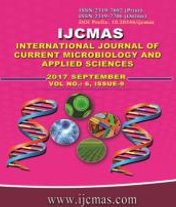


 National Academy of Agricultural Sciences (NAAS)
National Academy of Agricultural Sciences (NAAS)

|
PRINT ISSN : 2319-7692
Online ISSN : 2319-7706 Issues : 12 per year Publisher : Excellent Publishers Email : editorijcmas@gmail.com / submit@ijcmas.com Editor-in-chief: Dr.M.Prakash Index Copernicus ICV 2018: 95.39 NAAS RATING 2020: 5.38 |
Sesame (Sesamum indicum L.) (2n = 26), also known as Til or Gingelly, it is one of the most important oilseed crop of tropical and temperate regions. Mahalonobis D2 Statistics was applied to access the divergence among the 62sesame genotypes. The analysis of variance revealed significant differences among the genotypes for all the trait studied. The 62 genotypes were grouped into 6 clusters where, cluster I was largest containing 44 genotypes followed cluster II was twelve genotypes, cluster VI with three genotypes and cluster III, V, VI having solitary genotypes. The inter cluster distance was maximum between cluster IV and VI, minimum between cluster I and III, suggesting makeup of germplasm lines included in these clusters. Among the 10 quantitative traits studied the most important character contributing to the diversity was number of capsules per plant followed by harvest index, number of branches per plant, 1000 seed weight, number of seeds per capsule.
 |
 |
 |
 |
 |